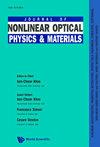用第一性原理计算揭示了硼空位驱动的alb2型二硼化钽的热力学稳定和力学性能的改善
IF 2.3
4区 物理与天体物理
Q2 OPTICS
引用次数: 1
摘要
通过第一性原理计算研究了缺硼alb2型二硼化钽(α−TaB 2−x)的热力学稳定性以及结构、电子和弹性性能。结果表明,即使在绝对零度下,α−TaB 2−x(0.167≤x≤0.25)也是热力学稳定的。另一方面,与α−TaB2相比,稳定的α−TaB2−x的剪切模量和杨氏模量以及硬度都更优越。α−TaB2−x相对于α−TaB2的相对稳定性和弹性性能的变化可以用填充在α−TaB2反键态的电子数量减少和空位周围断裂键数量增加之间的竞争效应来解释,这两者都是由硼空位浓度的增加引起的。良好之间的协议我们计算晶格参数,弹性模和硬度的α−标签2−x的实验测量数据as-synthesized AlB2-type钽二硼化物与标签的声称组成∼2,在文学,表明,而不是一条线与化学计量组成TaB2化合物,容易boron-deficient AlB2-type钽二硼化物,其稳定的构图平衡可能包括至少从TaB 1.75∼1.833∼选项卡。此外,在α - TaB2中硼原子空位的取代是导致wb2型二硼化钽和正交Ta2B3不稳定的原因,在之前的理论研究中预测在Ta - B体系中是热力学稳定的,因此可以解释为什么这两种化合物从未在实际实验中实现。本文章由计算机程序翻译,如有差异,请以英文原文为准。
Boron vacancy-driven thermodynamic stabilization and improved mechanical properties of AlB2-type tantalum diborides as revealed by first-principles calculations
Thermodynamic stability as well as structural, electronic, and elastic properties of boron-deficient AlB2-type tantalum diborides, which is designated as α− TaB 2−x , due to the presence of vacancies at its boron sublattice are studied via first-principles calculations. The results reveal that α− TaB 2−x , where 0.167 ≲x≲ 0.25, is thermodynamically stable even at absolute zero. On the other hand, the shear and Young’s moduli as well as the hardness of stable α− TaB 2−x are predicted to be superior as compared to those of α− TaB2. The changes in the relative stability and also the elastic properties of α− TaB 2−x with respect to those of α− TaB2 can be explained by the competitive effect between the decrease in the number of electrons filling in the antibonding states of α− TaB2 and the increase in the number of broken bonds around the vacancies, both induced by the increase in the concentration of boron vacancies. A good agreement between our calculated lattice parameters, elastic moduli and hardness of α− TaB 2−x and the experimentally measured data of as-synthesized AlB2-type tantalum diborides with the claimed composition of TaB ∼2 , available in the literature, suggests that, instead of being a line compound with a stoichiometric composition of TaB2, AlB2-type tantalum diboride is readily boron-deficient, and its stable composition in equilibrium may be ranging at least from TaB ∼1.833 to TaB ∼1.75 . Furthermore, the substitution of vacancies for boron atoms in α− TaB2 is responsible for destabilization of WB2-type tantalum diboride and orthorhombic Ta2B3, predicted in the previous theoretical studies to be thermodynamically stable in the Ta−B system, and it thus enables the interpretation of why the two compounds have never been realized in actual experiments.
求助全文
通过发布文献求助,成功后即可免费获取论文全文。
去求助
来源期刊
CiteScore
3.00
自引率
48.10%
发文量
53
审稿时长
3 months
期刊介绍:
This journal is devoted to the rapidly advancing research and development in the field of nonlinear interactions of light with matter. Topics of interest include, but are not limited to, nonlinear optical materials, metamaterials and plasmonics, nano-photonic structures, stimulated scatterings, harmonic generations, wave mixing, real time holography, guided waves and solitons, bistabilities, instabilities and nonlinear dynamics, and their applications in laser and coherent lightwave amplification, guiding, switching, modulation, communication and information processing. Original papers, comprehensive reviews and rapid communications reporting original theories and observations are sought for in these and related areas. This journal will also publish proceedings of important international meetings and workshops. It is intended for graduate students, scientists and researchers in academic, industrial and government research institutions.

 求助内容:
求助内容: 应助结果提醒方式:
应助结果提醒方式:


